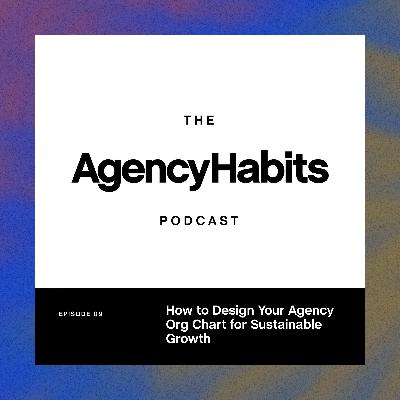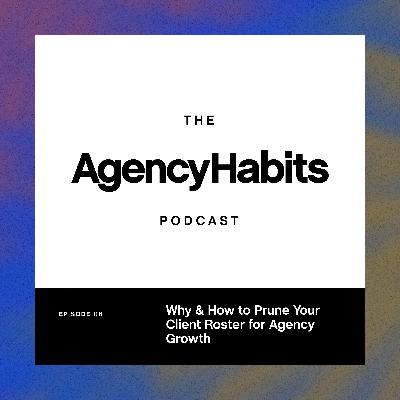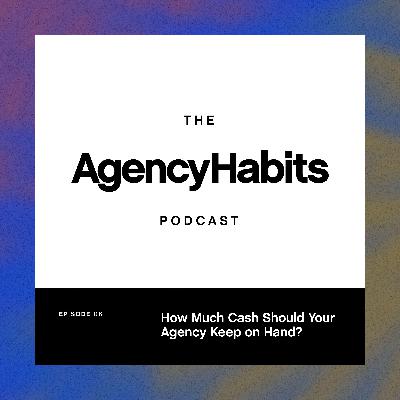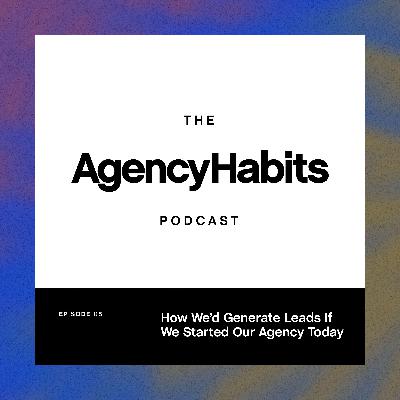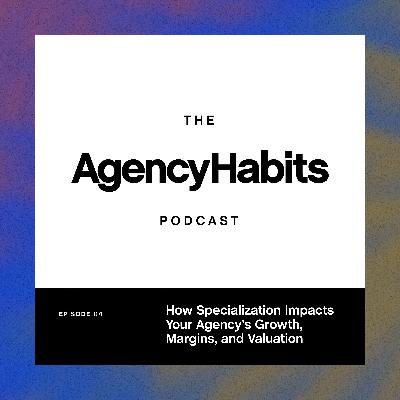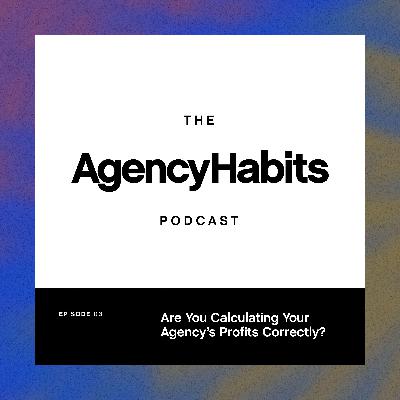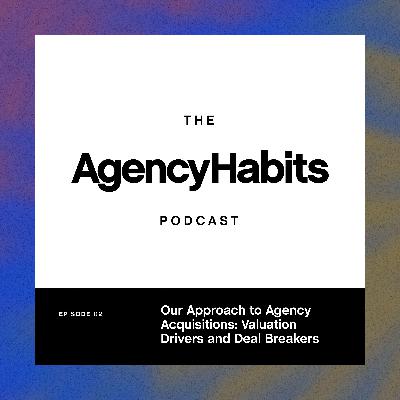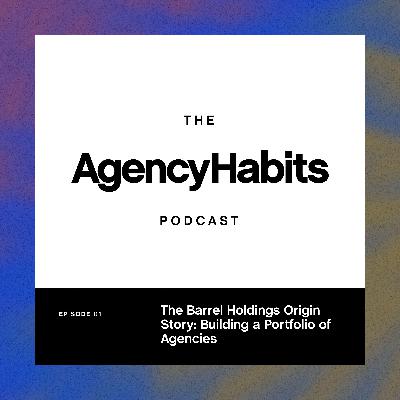Discover The AgencyHabits Podcast
The AgencyHabits Podcast

The AgencyHabits Podcast
Author: Peter Kang, Sei-Wook Kim
Subscribed: 0Played: 0Subscribe
Share
© 2025
Description
Go behind the scenes of real agency businesses. The AgencyHabits Podcast shares ideas, lessons, and experiments from across Barrel Holdings - home to a growing portfolio of specialized agencies and over two decades of insights. We share them all here, hoping you’ll test, tweak, and find what works best for your agency.
9 Episodes
Reverse
In this episode, hosts Peter Kang and Sei-Wook Kim pull back the curtain on one of the most critical yet often overlooked aspects of scaling an agency: organizational design. Starting from their own early days as a flat, "all-hands-on-deck" team, they trace the evolution of their org chart at Barrel as they grew, specialized roles, and built departments. Peter and Sei-Wook discuss the telltale signs that it's time to add structure, from the need for career paths and mentorship to managing increasing project complexity. They share practical advice on how founders can be more deliberate about org design, including the powerful exercise of visualizing your current and future org chart. They also get real about the challenges of scaling up and down, the pitfalls of over-specializing too early, and how to define leadership roles that match your agency's current stage of growth. Whether you're a solo founder feeling the strain or a growing team struggling with blurred lines, this episode offers a clear framework for building an intentional and effective organizational structure. Key Moments 1. The early days: Why flat orgs work (until they don't). 2. The catalyst for change: Needing career paths, mentorship, and clear leadership. 3. How project complexity forces specialization and new roles (PMs, QA, Strategists). 4. The pitfall of over-specializing and bloating project teams without budget support. 5. The danger of "orphaned" roles that report directly to founders. 6. Step 1: Understanding your own strengths and weaknesses as a founder. 7. Step 2: The power of visualizing your org chart to identify gaps and stragglers. 8. Step 3: Using the org chart as a strategic tool for future hiring and growth. 9. The hard reality: Scaling your org down in times of revenue decline. 10. Defining leadership roles: "Player-Coach" vs. "General Manager" at different stages. Real Talk Takeaways 1. Your org chart is a strategic tool, not an HR formality. Visualizing it is the first step to intentional growth. 2. Not all specialization is good. Adding roles increases overhead; it must be supported by project budgets and volume. 3. Founders must learn to let go. The goal is to move from being a "player" to a "GM" who focuses on org design and hiring. 4. Business isn't always up and to the right. You must be willing to dismantle roles you worked hard to build when revenue contracts. 5. Hire leaders for the stage you're in. A "Director" at a 20-person agency needs to be hands-on, not just managerial. 6. Clarity is kindness. Clear role definitions, career progressions, and reporting lines build trust and accountability. 7. The ultimate leverage for a founder is designing an org where the right people are in the right seats. Timestamps 00:00 – Welcome to Agency Habits 00:06 – Why org design is a recurring pain point for scaling agencies 00:39 – The early days: Fluid roles, flat structures, and everyone wearing multiple hats 01:33 – The turning point: Needing structure for career growth and mentorship 02:10 – How project complexity (bigger teams, more disciplines) forces org evolution 03:43 – The transition: Creating departments, defining roles, and establishing leadership 05:48 – The double-edged sword of specialization: Efficiency vs. overhead & silos 07:24 – The critical link between project budgets, team size, and agency margins 08:11 – The problem of "orphaned" roles that lack a clear reporting line 09:00 – Advice for founders: How to start being deliberate about org design 10:00 – Step 1: Map your current org chart to visualize reporting lines and gaps 11:00 – Step 2: Create a future org chart to plan hires and growth deliberately 12:22 – Integrating org design with performance management and career progression 13:29 – How org design gave the founders the confidence to exit day-to-day operations 14:17 – The hardest part: Letting go, trusting your team, and allowing them to learn 14:46 – The founder's evolution: From "player" to "General Manager" 16:05 – The reality check: Scaling your org down during stagnant or declining revenue 17:04 – The sunken cost fallacy: Why you can't cling to overhead roles in a downturn 19:22 – Strategies for contracting: Transparency, fractional roles, and re-consolidating hats 20:13 – Defining leadership: "Player-Coach" vs. "General Manager" at different scales 22:47 – How to think about a leader's utilization and their impact on the entire team 23:19 – Wrap-up: The importance of intentional org design Notable Quotes "The org chart was very flat... it became unclear who reports to whom, what everyone's responsibility is." "Effective org design needs to also reflect the type of work that you do and the way that your project or engagement teams are constructed." "Once we started using the org chart as a tool, it was really helpful... we started having discussions around job descriptions, who reports to who, and how we measure success." "The first thing for a founder is understanding your own strengths and weaknesses." "As the founder, the leader, you're really trying to get to a point where your main lever of impact is the org design and then recruiting the right people and holding them accountable to results." "Business isn't always up and to the right... you may need to make changes in the business that are kinda the opposite of what you put in place." "You almost have to kind of see the warning signs, make the decisive move to slim it down... you can't cling to the facade of the infrastructure you built." "It's always a balance, but just understanding... how are they using their time and what's the best use of their energy." Links & Resources Peter Kang on LinkedIn: https://www.linkedin.com/in/peterkang34/ Sei-Wook on LinkedIn: https://www.linkedin.com/in/seiwookkim/ AgencyHabits Website: https://www.agencyhabits.com/ AgencyHabits on LinkedIn: https://www.linkedin.com/company/agencyhabits/ Barrel Holdings Website: https://www.barrel-holdings.com/ Barrel Holdings LinkedIn: https://www.linkedin.com/company/barrel-holdings/
In this episode, hosts Peter Kang and Sei-Wook Kim dive into one of the most challenging but necessary decisions agency leaders face: when and how to let go of clients. As agencies grow, not every client remains a good fit. Peter and Sei-Wook break down the key factors to consider when evaluating your client roster, from strategic alignment and profitability to relationship quality and payment behavior. They share real-world examples from their own experiences at Barrel, including how shifting their focus to Shopify-led projects meant parting ways with clients on other platforms. They also tackle tough topics like dealing with unprofitable accounts, managing difficult client relationships, and knowing when to walk away from a high-risk engagement. Whether you're struggling with client concentration, operational overload, or simply want to build a more intentional client portfolio, this episode offers a practical framework for making proactive, strategic decisions that support long-term agency health. Key Moments 1. Why “pruning” your client list is essential for sustainable growth. 2. How to assess strategic fit using your Ideal Client Profile (ICP). 3. When to prioritize profitability over revenue. 4. Evaluating account expansion potential vs. dead-end relationships. 5. The role of relationship quality and access to decision-makers. 6. Red flags in client payment behavior and how to respond. 7. Managing operational load and protecting team morale. 8. Weighing the marketing value of a client (case studies, brand credibility). 9. Understanding risk factors like client concentration and legal exposure. 10. Knowing when to bow out of a project, even after it’s started. Real Talk Takeaways 1. Not all revenue is good revenue. Unprofitable clients can drain resources and morale. 2. Strategic fit matters. Align your client roster with where you’re going, not where you’ve been. 3. Payment behavior is a leading indicator of respect, and risk. 4. Protect your team. Difficult clients can cause burnout and turnover. 5. Sometimes the best business decision is to fire a client. 6. Leaders must own the tough calls. Don’t push them down to the team. 7. Risk isn’t always financial, reputational and legal risks can be just as damaging. Timestamps 00:00 – Welcome to Agency Habits 00:19 – Why agencies need to regularly assess client fit 01:35 – The tree-pruning analogy for agency growth 01:56 – Factor #1: Strategic fit & Ideal Client Profile (ICP) 03:46 – Barrel’s experience with platform fragmentation 04:45 – Factor #2: Gross margin & profitability 06:15 – The trap of “ossified” unprofitable relationships 07:31 – Factor #3: Account expansion potential 08:55 – How to allocate resources based on growth potential 10:18 – Factor #4: Relationship quality & access to decision-makers 12:19 – When bad behavior justifies ending a relationship 13:21 – Factor #5: Payment behavior & red flags 15:06 – Why agencies aren’t banks—setting payment boundaries 17:32 – Factor #6: Operational load & team impact 20:43 – How to give feedback to high-maintenance clients 22:33 – The leadership decision to protect the team 23:41 – Factor #7: Case study & marketing value 25:28 – When you can’t talk about the work (e.g., Apple) 26:38 – Factor #8: Risk (concentration, reputation, legal) 28:14 – Reputational risks and company values 29:26 – When to walk away from an oversold project 30:41 – Wrap-up: Making proactive decisions for growth Notable Quotes “They are the people that are paying you now and are supporting your business, but that doesn’t mean they’re the right fit for the next phase of your growth.” “Agencies are not banks. We’re not here to lend unlimited credit to our clients.” “If you don’t make the decision, it could cause burnout turnover. If you do make a quick decision, you can build a lot of trust.” “Not every client needs to be a case study, but every client should align with your values and operational sanity.” “Sometimes it’s better to bow out and take the hit immediately versus a much bigger problem down the road.” Links & Resources Peter Kang on LinkedIn: https://www.linkedin.com/in/peterkang34/ Sei-Wook on LinkedIn: https://www.linkedin.com/in/seiwookkim/ AgencyHabits Website: https://www.agencyhabits.com/ AgencyHabits on LinkedIn: https://www.linkedin.com/company/agencyhabits/ Barrel Holdings Website: https://www.barrel-holdings.com/ Barrel Holdings LinkedIn: https://www.linkedin.com/company/barrel-holdings/
In this episode, hosts Peter Kang and Sei-Wook Kim dive into the core habits that have driven their agencies’ success over the years. From structured team reviews and client communications to proactive outreach and financial discipline, they break down 10 essential routines (plus a few bonus ones) that help agencies improve continuously, stay aligned, and grow sustainably. Peter and Sei-Wook share personal stories and practical advice on implementing habits like After Action Reviews, weekly biz dev meetings, monthly newsletters, and quarterly business reviews. They also explore how these habits compound over time, strengthen culture, prevent problems, and unlock new opportunities. Whether you’re a solo operator or leading a team, this episode offers an actionable framework to build consistency, accountability, and resilience into your agency’s DNA. Key Moments 1. How After Action Reviews turn project learnings into process improvements. 2. Why weekly business development meetings keep the pipeline full and the team aligned. 3. The role of monthly all-hands meetings in celebrating wins and maintaining morale. 4. How consistent weekly outreach emails can lead to multi-million dollar opportunities. 5. Using monthly newsletters to stay top-of-mind with clients and partners. 6. The importance of weekly client account check-ins to anticipate issues and opportunities. 7. How Quarterly Business Reviews (QBRs) deepen client relationships and unlock growth. 8. Why “mining the bottom”—addressing underperformers—is crucial for culture. 9. The value of client feedback surveys in improving service and offering. 10. Setting and reviewing annual and quarterly goals to drive focused growth. Real Talk Takeaways 1. Habits compound. Small, consistent actions lead to big results over time. 2. Debrief everything. Learning from wins and losses prevents repeat mistakes. 3. Outreach is everything. Relationships built today can save your business tomorrow. 4. Culture is performance. Tolerating underperformers drags everyone down. 5. Goals need rhythm. Annual vision without quarterly check-ins is just a wishlist. 6. Cashflow isn’t optional. Weekly finance reviews prevent surprises. 7. Always be recruiting. Even if you’re not hiring, stay connected to talent. Timestamps 00:00 – Welcome to Agency Habits 00:52 – Habit #1: After Action Reviews 02:32 – Habit #2: Weekly Business Development Meetings 04:39 – Habit #3: Monthly Team Meetings 06:46 – Habit #4: Weekly Outreach Emails 09:19 – Habit #5: Monthly Newsletter Emails 11:16 – Habit #6: Weekly Client Account Check-Ins 13:37 – Habit #7: Quarterly Business Reviews (QBRs) 16:58 – Habit #8: Mining the Bottom (Performance Management) 19:21 – Habit #9: Client Feedback Surveys 21:02 – Habit #10: Annual & Quarterly Goal Setting 23:55 – Bonus Habits: Weekly Finance Reviews, Org Chart Reviews, Always Be Recruiting, Utilization & Forecasting 31:07 – Wrap-up and where to learn more Notable Quotes “A lot of what makes agencies successful are not just one-off big actions, but consistent activities that compound over time.” “The weekly outreach email is a multi-million dollar habit.” “If you’re allowing underperformers to continue, you’re dragging the entire culture down.” “Reserves aren’t for funding losses, they’re for timing mismatches.” “Goals without a plan are just a wishlist. You have to work backwards from the number.” Links & Resources Peter Kang on LinkedIn: https://www.linkedin.com/in/peterkang34/ Sei-Wook on LinkedIn: https://www.linkedin.com/in/seiwookkim/ AgencyHabits Website: https://www.agencyhabits.com/ AgencyHabits on LinkedIn: https://www.linkedin.com/company/agencyhabits/ Barrel Holdings Website: https://www.barrel-holdings.com/ Barrel Holdings LinkedIn: https://www.linkedin.com/company/barrel-holdings/
In this episode, hosts Peter Kang and Sei-Wook Kim talk about the critical yet often overlooked topic of cashflow management for agencies. They share lessons on balancing profitability with liquidity, designing client contracts to align cash inflows with outflows, and determining the right amount of cash reserves to weather uncertainties. From the pitfalls of 50/50 payment structures to the advantages of retainer-based models, Peter and Sei-Wook explore practical strategies to avoid cash crunches. They also discuss the emotional and financial challenges of using reserves to sustain operations during downturns, the role of insurance and credit lines as safety nets, and how centralized cashflow management works in a multi-agency portfolio. Whether you're a solo founder or managing multiple agencies, this episode offers actionable insights to build a financially resilient business. Key Moments 1. Why a profitable P&L doesn’t always mean money in the bank. 2. How lumpy payment structures can create cashflow nightmares. 3. Shifting to frequent, project-aligned invoicing to smooth cashflow. 4. Why retainers create positive cash conversion cycles. 5. How much cash to hold (1–6 months of expenses) and when to distribute profits. 6. The risks of over-relying on cash buffers to delay tough decisions. 7. Building granular cashflow projections to avoid insolvency. 8. Centralized finance strategies for portfolio businesses. 9. Insurance, credit lines, and owner investments as backup plans. Real Talk Takeaways 1. Profit isn’t equal to Cash. Accrual accounting masks timing mismatches between revenue and actual payments. 2. Design payments like payroll…invoice frequently to mirror when work is done, not when projects end. 3. Retainers are KING. They provide float by collecting cash before incurring expenses. 4. Hoarding cash can mask operational inefficiencies. 5. Cut costs early. Delaying tough decisions burns reserves faster than expected. 6. Insure against disasters…legal liabilities can dwarf cash reserves overnight. 7. Credit Lines = Emergency use only. It is cheaper to use your own cash than pay high interest. Timestamps 00:00 – Welcome to Agency Habits 00:52 – The disconnect between P&L profitability and bank balances 02:40 – How 50/50 payment structures create cash gaps 04:27 – Best practices: Frequent invoicing and expense matching 06:33 – Retainer models and the power of positive float 08:07 – Handling prepayments (don’t treat them as instant profit!) 09:15 – How much cash to hold (1–6 months of expenses) 12:04 – The emotional dilemma: Using reserves to save jobs vs. facing reality 15:12 – The lifesaving role of granular cashflow forecasting 18:07 – Multi-agency cashflow: Centralized reserves and holding company strategies 20:06 – Insurance and credit lines as last-resort safeguards 23:41 – Final advice: Keep 1–6 months of cash, separate reserves from growth investments Notable Quotes "Cash is the lifeline of whether you can run your business day to day." "On paper, you might have amazing profits, but the bank account tells a different story." "If you’re paying team members before clients pay you, you’re playing with fire." "Reserves aren’t for funding losses, they’re for timing mismatches." "A lawsuit could tank not just your cash, but your entire business." Links & Resources Peter Kang on LinkedIn: https://www.linkedin.com/in/peterkang34/ Sei-Wook on LinkedIn: https://www.linkedin.com/in/seiwookkim/ AgencyHabits Website: https://www.agencyhabits.com/ AgencyHabits on LinkedIn: https://www.linkedin.com/company/agencyhabits/ Barrel Holdings Website: https://www.barrel-holdings.com/ Barrel Holdings LinkedIn: https://www.linkedin.com/company/barrel-holdings/
In this episode, hosts Peter Kang and Sei-Wook Kim take listeners on a journey back to their agency's origins, sharing hard-won insights about building a business from scratch with limited connections and resources. They explore the strategies that helped them jumpstart Barrel 19 years ago, from leveraging personal networks to building lasting client relationships that compound over time. The conversation covers everything from their early days doing pro bono work for nonprofits to developing systematic approaches for staying top-of-mind with past clients and building referral networks. They also discuss the importance of treating every client engagement, regardless of budget, as a premium experience that can lead to future opportunities. Whether you're starting an agency from zero or looking to revitalize your lead generation, this episode offers actionable strategies for building sustainable business growth through relationships and consistent execution. Key Moments 1. How accepting any paying work helped build their initial portfolio 2. Why treating free work like premium engagements pays dividends 3. Leveraging Korean-American nonprofits and Columbia connections for early opportunities 4. How Silicon Alley networking opened doors to new partnerships 5. Creating mutually beneficial relationships with complementary agencies 6. How one satisfied client can multiply into multiple referrals over time 7. The weekly habit that saved their business during a revenue shortfall 8. Why aligning with growing tech platforms like Shopify creates tailwinds Real Talk Takeaways 1. Every client is a marketing investment. Deliver premium experiences regardless of budget size. 2. Relationships compound over decades...people you meet today may become major clients years later. 3. In-person connections still matter. Virtual networking can't fully replace face-to-face relationship building. 4. Consistency beats intensity. Regular weekly outreach trumps sporadic burst efforts. 5. Diversify your lead sources…don't put all eggs in one referral basket. 6. Documentation drives visibility. Invest time in case studies and sharing your work. 7. Platform timing matters! Getting in early with growing tech platforms can provide significant advantages. Timestamps 00:00 – Welcome to Agency Habits 00:26 – The origin story: starting Barrel 19 years ago fresh out of college with no connections 02:18 – Strategic pro bono work: using nonprofit projects to access seasoned professionals 04:24 – Treating low-budget and pro bono clients with premium service as marketing investment 07:46 – The reality check: building networks takes years, not months 09:22 – The irreplaceable value of in-person relationship building 10:46 – Building referral networks with complementary agencies 15:05 – Systematic relationship maintenance: weekly outreach to past connections 19:40 – Platform partnerships: the Shopify success story and partnership team relationships 23:31 – The foundation principle: none of this works without excellent client delivery Notable Quotes "Just because somebody is paying you nothing or little doesn't mean you should give them a less than premium experience." "The best form of marketing is a happy customer." "If you start doing it when you need it, then it's probably too late at that point." Links & Resources Peter Kang on LinkedIn: https://www.linkedin.com/in/peterkang34/ Sei-Wook on LinkedIn: https://www.linkedin.com/in/seiwookkim/ AgencyHabits Website: https://www.agencyhabits.com/ AgencyHabits on LinkedIn: https://www.linkedin.com/company/agencyhabits/ Barrel Holdings Website: https://www.barrel-holdings.com/ Barrel Holdings LinkedIn: https://www.linkedin.com/company/barrel-holdings/
In this episode, Peter Kang and Sei-Wook Kim dive deep into agency specialization and how narrowing focus has become a key driver of growth across their Barrel Holdings portfolio. From the evolution of Barrel's journey from generalist to CPG eCommerce specialists, to the strategic positioning of BX Studio as Webflow experts, they share practical insights on when and how to specialize. They explore the trade-offs between being a full-service generalist versus developing deep expertise in specific verticals or capabilities. The conversation covers real-world examples of how specialization leads to stronger client relationships, higher margins, and better valuations - while addressing the practical realities of when to take work outside your niche. You'll get actionable frameworks for identifying specialization opportunities, plus book recommendations from industry thought leaders who've shaped their approach to positioning and expertise development. Key Moments 1. Defining specialization vs. positioning: internal expertise vs. external messaging 2. The generalist trap: why being everything to everyone limits impact 3. Barrel's evolution from investment bank + nail salon clients to CPG eCommerce focus 4. How platform specialization (Shopify) created competitive advantage 5. Adding vertical focus (CPG food & beverage) for deeper differentiation 6. BX Studio's Webflow expertise and potential hospitality vertical expansion 7. The business case for specialization: retention, pricing power, and margins Real Talk Takeaways 1. Specialization builds trust. Clients choose agencies that have solved their exact problems before. 2. Pattern matching accelerates results. Deep expertise means faster problem-solving and better outcomes. 3. You can still take other work. Specialization is about positioning, not absolute exclusion. 4. Look for clusters in your client base. Your next specialization might already be hiding in your portfolio. 5. Small agencies need focus more than large ones. Scale can compensate for generalization, but boutique agencies need differentiation. 6. Specialized agencies command higher multiples. Better margins and client retention directly impact valuations. Timestamps 00:00 – Welcome to Agency Habits 00:18 – Defining specialization: internal expertise vs. external positioning 01:47 – Why specialization matters: the generalist agency trade-offs 04:50 – Barrel's specialization journey: from generalist to CPG eCommerce experts 07:26 – Can you take work outside your specialization? 09:35 – Moving toward specialization: practical tips for generalist agencies 12:14 – Why Barrel Holdings focuses on specialized agencies 14:40 – Book recommendations for agency positioning and specialization Notable Quotes "Specialization is really about defining what you're gonna master as a business." "There's bound to be clusters where you've done something more than once, and then from there, understanding how you can go deeper." "Specialization offers a degree of durability and profitability that drives value." Links & Resources Peter Kang on LinkedIn: https://www.linkedin.com/in/peterkang34/ Sei-Wook on LinkedIn: https://www.linkedin.com/in/seiwookkim/ AgencyHabits Website: https://www.agencyhabits.com/ AgencyHabits on LinkedIn: https://www.linkedin.com/company/agencyhabits/ Barrel Holdings Website: https://www.barrel-holdings.com/ Barrel Holdings LinkedIn: https://www.linkedin.com/company/barrel-holdings/ "The Business of Expertise" by David C. Baker "Anyone, Not Everyone" by Corey Quinn "Positioning for Professionals" by Tim Williams
In this episode, Peter Kang and Sei-Wook Kim tackle one of the most confusing aspects of agency financials: how to properly calculate profitability. They break down the critical difference between SDE (Seller's Discretionary Earnings) and EBITDA, explaining why these metrics can paint vastly different pictures of the same business. Using concrete examples and spreadsheet walkthroughs, they demonstrate how owner salary calculations can dramatically impact reported profitability margins…sometimes swinging from 15% to 40% depending on how compensation is structured. This episode is essential for any agency owner who wants to understand their true financial performance and how acquirers evaluate businesses. You'll learn why a "normalized" view of profitability matters, how replacement cost thinking changes valuation conversations, and why scale affects the relationship between owner compensation and overall margins. Key Moments 1. Defining SDE vs. EBITDA and why the distinction matters for agency owners 2. Breaking down a sample P&L to show real-world profitability calculations 3. How owner salary manipulation can inflate or deflate EBITDA percentages 4. The "replacement cost" framework for normalizing owner compensation 5. Why these calculations become less volatile as agencies scale to $10M+ revenue 6. How Barrel Holdings adjusts for owner salary when evaluating acquisitions 7. The importance of understanding your true role and replacement value Real Talk Takeaways 1. SDE includes owner compensation; EBITDA doesn't - know which metric you're using 2. Owner salary swings can create 10-20% margin differences in smaller agencies 3. Replacement cost thinking is key…what would you pay someone to do your job? 4. Scale reduces volatility - larger agencies see smaller percentage swings from owner comp 5. Normalize before you negotiate. Buyers will adjust your numbers anyway 6. 40% "profit" might actually be 25% EBITDA when properly calculated 7. Context matters. Highly involved owners need higher replacement cost estimates Timestamps 00:00 – Welcome to Agency Habits 00:18 – Why profitability discussions often aren't apples-to-apples comparisons 00:44 – Defining SDE (Seller's Discretionary Earnings) vs. EBITDA 01:12 – The importance of understanding these different calculation methods 01:59 – Walking through concrete spreadsheet examples 02:11 – Sample P&L breakdown: $1M revenue agency with $500K COGS 02:35 – What constitutes COGS in an agency business 03:10 – SG&A expenses and how owner salary factors into calculations 03:56 – SDE calculation: adding back owner salary for 40% margin 04:26 – Why owners might take distributions instead of fixed salaries 05:18 – EBITDA scenarios: how different owner salaries create different margins 06:11 – The "too low" scenario: $65K salary inflating EBITDA to 33.5% 06:40 – The "too high" scenario: $250K salary depressing EBITDA to 15% 07:48 – How Barrel Holdings normalizes owner salary for fair comparisons 08:23 – The replacement cost framework for owner compensation 09:27 – Adjusting EBITDA calculations based on realistic replacement costs 10:38 – Why Barrel Holdings requires 15% EBITDA using their calculation method 11:22 – How these calculations change dramatically at scale 11:56 – $10M revenue example: why percentages converge at larger scale 12:57 – When owner salary becomes negligible in large, structured agencies 13:26 – The importance of understanding owner role and replacement cost 13:43 – Practical advice for agency owners on calculating true profitability Notable Quotes "It's not always clear what they mean. Are they talking about their profit after paying them a market salary? Are they excluding their comp? Is that inflating their numbers?" "We're really thinking about what is the replacement cost of that person and making sure that's accurately reflected in the EBITDA." "Just because your SDE is 400K doesn't mean you're pocketing 400K because there is something to be paid to Uncle Sam." Links & Resources Peter Kang on LinkedIn: https://www.linkedin.com/in/peterkang34/ Sei-Wook on LinkedIn: https://www.linkedin.com/in/seiwookkim/ AgencyHabits Website: https://www.agencyhabits.com/ AgencyHabits on LinkedIn: https://www.linkedin.com/company/agencyhabits/ Barrel Holdings Website: https://www.barrel-holdings.com/ Barrel Holdings LinkedIn: https://www.linkedin.com/company/barrel-holdings/
In this episode of Agency Habits, Peter Kang interviews Sei-Wook Kim on the inner workings of agency acquisitions and valuations at Barrel Holdings. They break down the exact criteria they use when evaluating whether to acquire an agency and explain the logic behind their valuation framework: what increases the price, what brings it down, and how seller goals shape the final deal. If you're building an agency with the intention to sell (now or years from now), this episode will help you understand how experienced buyers actually think: what they're measuring, what red flags they catch fast, and what signals a business is built to last. They also discuss the emotional side of selling, legacy, and the difference between cashing out and compounding long-term value. Key Moments 1. Why Barrel Holdings pivots between building and buying agencies 2. The evolution of their acquisition criteria and "buy box" parameters 3. How specialization drives both defensibility and higher valuations 4. The critical importance of recurring revenue and client diversification 5. Why proprietary technology can actually hurt agency valuations 6. How seller motivations dramatically impact deal structure and pricing 7. The emotional side of agency sales and preserving legacy Real Talk Takeaways 1. Recurring revenue and retention unlock higher multiples. 2. Agencies with clear positioning and playbooks stand out fast. 3. Client and lead source concentration are silent risks buyers notice immediately. 4. Founders who’ve stepped back (and trained successors) are more valuable. 5. Legacy matters. Some sellers will trade upside for story. Timestamps 00:00 – Welcome to Agency Habits 00:33 – Why buy versus build? The acceleration advantage of acquisitions 02:08 – Inside Barrel Holdings' "buy box" criteria: $2-10M revenue, 15%+ EBITDA 03:23 – How deal size and structure constraints shape acquisition strategy 03:41 – The power of specialization: why niche agencies win 05:14 – Platform plays: riding the growth wave of Shopify and Webflow 05:31 – Top value drivers: what makes agencies worth more 06:44 – The importance of predictable, recurring revenue streams 07:10 – Revenue consistency vs. growth: why stable beats volatile 08:20 – Client concentration red flags: the 15-20% danger zone 09:30 – How agency reputation manifests in organic deal flow 10:08 – Business development diversification: avoiding single-source risk 10:49 – Team retention, margin efficiency, and operational excellence 12:17 – The nuance of employee retention: performance vs. loyalty 12:55 – What's less important: proprietary tech and unsustainable growth 15:44 – How seller goals affect valuation and deal structure 17:14 – Risk pricing: why seller involvement impacts multiples 18:05 – The emotional side: legacy, brand preservation, and life circumstances 20:03 – Wrapping up: the complexity beyond pure numbers Notable Quotes "Consistency helps give us the confidence that future years will look like the past years." “Specialization isn’t just for SEO, it’s your valuation strategy.” “High revenue with low margin? That’s not scale, it’s a red flag.” “Legacy isn't soft. It shapes how sellers price the future.” “The emotional story behind the numbers tells us more than the deck ever will.” Links & Resources Peter Kang on LinkedIn: https://www.linkedin.com/in/peterkang34/ Sei-Wook on LinkedIn: https://www.linkedin.com/in/seiwookkim/ AgencyHabits Website: https://www.agencyhabits.com/ AgencyHabits on LinkedIn: https://www.linkedin.com/company/agencyhabits/ Barrel Holdings Website: https://www.barrel-holdings.com/ Barrel Holdings LinkedIn: https://www.linkedin.com/company/barrel-holdings/
In this inaugural episode, Peter Kang and Sei-Wook Kim share the unfiltered origin story behind Barrel Holdings. From their humble beginnings building table-based websites in college to growing a multi-agency portfolio serving CPG brands, startups, and enterprise clients, this conversation charts nearly two decades of lessons in agency building, client service, and entrepreneurial evolution. They walk us through key inflection points: like quitting Wall Street, bootstrapping through Craigslist hires, launching Barrel, and ultimately spinning off multiple high-performing specialized agencies. You’ll also get a behind-the-scenes look at their first acquisition and why they’ve committed to a long-term, compounding approach to holding company success. Key Moments 1. How a student club and side hustle led to a full-time agency career 2. What triggered the shift from full-service to eComm & Shopify specialization 3. Why spinning off legacy clients into Vaulted Oak became a lightbulb moment 4. The strategic difference between launching vs. acquiring agencies 5. How handing off CEO roles created operational leverage and personal peace 6. Their investment thesis: small, durable, cash-flowing specialist agencies 7. Why “focus” is the most underrated agency growth strategy Real Talk Takeaways 1. Cash flow is the new growth. The best agency is a durable one. 2. Don’t cling to legacy clients, spin them off and build anew. 3. Leadership handoff works...if you prepare for it years in advance. 4. Platform plays (Shopify, Webflow) can be major growth engines. 5. A great operator is your biggest unlock post-acquisition. Timestamps 00:00 – Welcome to Agency Habits 00:35 – How Peter & Wook started freelancing in college 02:40 – Quitting Lehman to go full-time with Barrel 05:00 – The iPad-era boom and scaling through partnerships 07:09 – Betting early on Shopify & selling themes 09:30 – Launching Vaulted Oak to support legacy clients 12:00 – Webflow’s rise & the BX Studio playbook 16:41 – Spinning up Bolster and appointing Barrel’s new CEO 21:00 – Their first acquisition: the story of Catalog 26:00 – Inside the Barrel Holdings portfolio strategy 35:00 – Why long-term cashflow matters more than quick exits 37:56 – Building community and future plans for Agency Habits Notable Quotes “The power of focus became crystal clear the moment we handed off CEO to someone who could give 100%.” “We weren’t tired or burnt out after 18 years. We wanted to go deeper.” “If the structure is right, the business runs better. Period.” Links & Resources Peter Kang on LinkedIn: https://www.linkedin.com/in/peterkang34/ Sei-Wook on LinkedIn: https://www.linkedin.com/in/seiwookkim/ AgencyHabits Website: https://www.agencyhabits.com/ AgencyHabits on LinkedIn: https://www.linkedin.com/company/agencyhabits/ Barrel Holdings Website: https://www.barrel-holdings.com/ Barrel Holdings LinkedIn: https://www.linkedin.com/company/barrel-holdings/
Comments
 United States
United States

